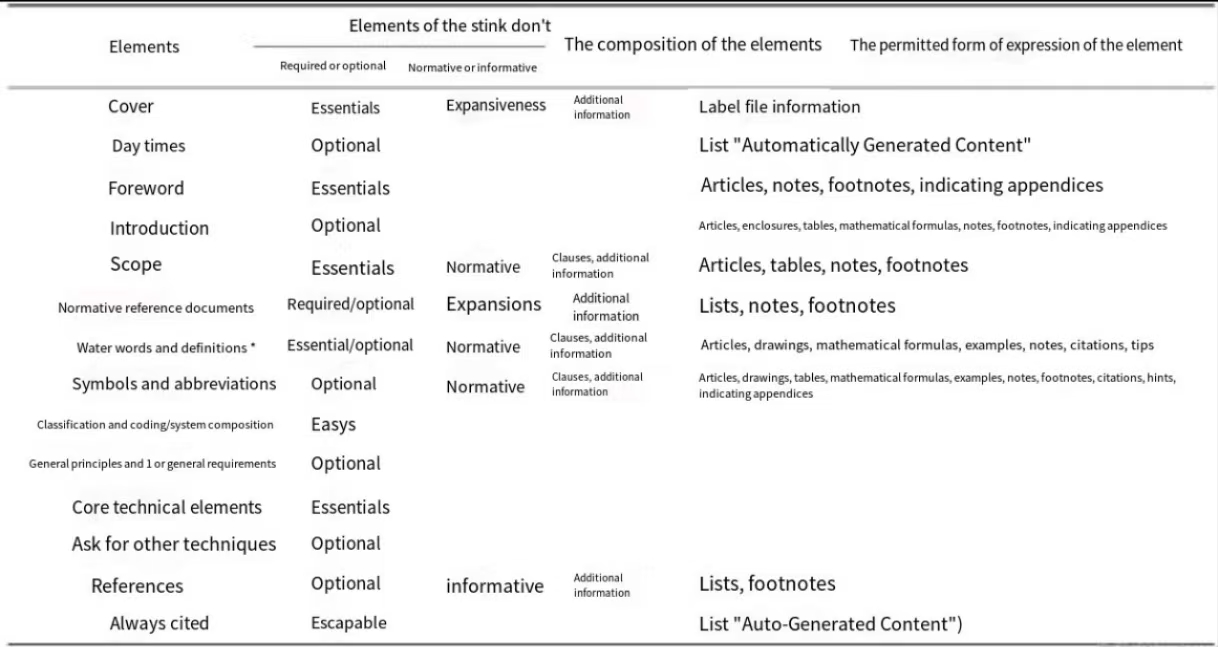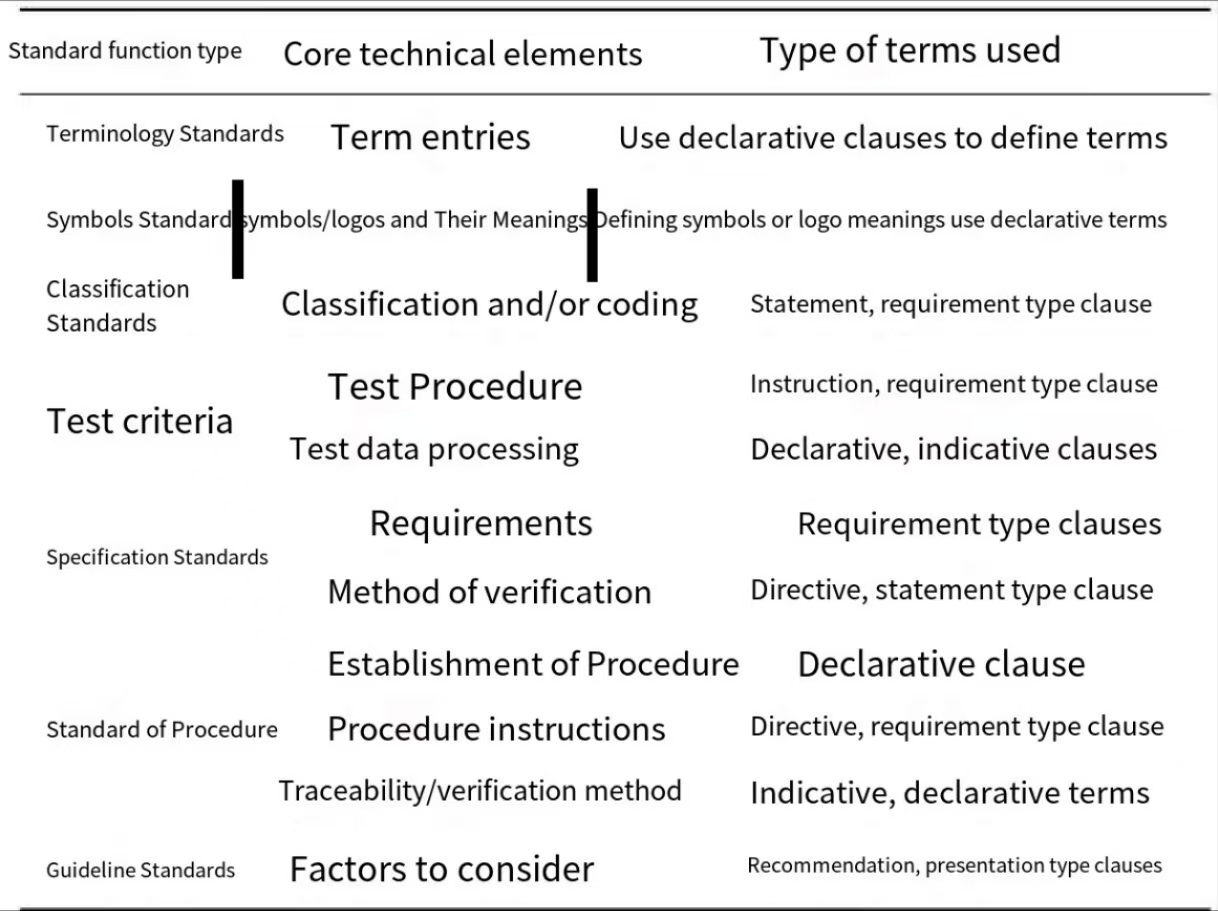Resource Center
GB/T 1.1—2020, *Directives for Standardization—Part 1: Structure and Drafting of Standardization Documents*, is the most fundamental standard for guiding the standard writing work. It establishes the structure of standardization documents as well as the overall principles and requirements for document drafting. It consists of a total of 10 chapters and 6 appendices. The main technical contents include: the objectives, principles and requirements of standardization documents, their structure, the writing and expression of elements, and the layout format. The main content changes in the new version are as follows:
1. Major Adjustments
Compared with GB/T 1.1—2009, GB/T 1.1—2020 has made major adjustments in three aspects: Firstly, it generally establishes the principles and requirements for drafting standardization documents, covering the principles for preparing a document as a whole or dividing it into several parts, the selection principles for normative elements, and the expression principles for documents, providing macro guidance for the drafting of various standardization documents. Secondly, it adds the classification of standardization documents, the writing rules for core technical elements, and the writing rules for the normative element "General Principles and/or General Requirements". Thirdly, in the expression of elements, it clearly defines provisions and additional information.
2. Other Adjustments
2.1 Cover, Foreword and Introduction
The title of the standard has been changed from *Directives for Standardization—Part 1: Structure and Drafting of Standards* to *Directives for Standardization—Part 1: Structure and Drafting Rules of Standardization Documents*. The provisions on the types of clauses that are not allowed to be used when writing the foreword have been changed. For example, the foreword should not contain requirements, instructions, recommendations or permissive clauses, nor should it use expressions such as figures, tables or mathematical formulas. The foreword should not give chapter numbers and should not be divided into sub-items. The provisions on the need to set an introduction under certain conditions and the specific background information that needs to be provided when writing the introduction have been added.
2.2 Scope
The types of clauses and expression forms used in the scope have been changed. The scope is changed to "This document establishes the structure of standardization documents and the overall principles and requirements for their drafting, and specifies the writing and expression rules for document titles, levels, elements, as well as the layout format of documents."
2.3 Terms and Definitions, Symbols and Abbreviations
The introductory words have been revised. Terms and definitions are divided into three major categories: documents, document structure, and document expression. Three terms and definitions related to documents, such as "standardization documents", have been added. Two terms and definitions related to document structure, namely "structure" and "body text", have been added. Three terms and definitions related to document expression, such as "instruction", have been added. Three types of introductory words for introducing lists of symbols and/or abbreviations have been added.
2.4 Categories of Documents
The section "Categories of Documents" has been added, along with an explanation of the categories of standardization documents and the basis for classification. There are a large number of standardization documents with a wide range. According to different attributes, documents can be classified into different categories. Confirming the category of a standard can help drafters create more applicable standards. International standardization documents usually include categories such as standards, technical specifications (TS), publicly available specifications (PAS), technical reports (RT), guidelines (Guide), and certain parts of documents.
2.5 Objectives, Principles and Requirements
Chapter 4 "General Provisions" in the 2009 version has been changed to Chapter 5 "Objectives, Principles and Requirements" in the 2020 version. The principles have been further subdivided, and relevant contents from the 2009 version have been revised and incorporated into Chapter 5. Chapter 5 of the new version stipulates the objectives of document preparation and the overall principles that should be followed to achieve these objectives. It also stipulates the principles for preparing a document as a whole or dividing it into parts, the selection principles for normative elements, the expression principles for documents, and the general requirements.
2.6 Document Titles and Structure
Words indicating the functional types of standards and their English translations have been added to "Document Titles", as shown in Table 1. The categories, compositions, and expression forms of elements have been changed. The expression forms of elements have been simplified into informative elements, normative elements, mandatory elements, and optional elements, as shown in Table 2.
Table 1 Words indicating the functional types of standards in document titles

Table 2 Categories, Compositions and Expression Forms of Various Elements in Documents

*The setting of chapter numbers and titles is mandatory, and whether the element content is included or not shall be selected according to the specific circumstances.
2.7 Writing of Hierarchies
The specific forms of enumerated items have been changed to two types. One is to use a complete sentence followed by a period to introduce each item, which is also followed by a period; the other is to use text followed by a colon to introduce each item, which is followed by a semicolon or a comma. The writing rules for enumerated items have been refined.
2.8 Writing of Elements
The performance principle in the old version has been deleted, and the writing rules for core technical elements and other technical elements have been added. The core technical elements of various functional types of standards and the types of clauses used are shown in Table 3.
Table 3 Core Technical Elements of Various Functional Types of Standards and the Types of Clauses Used

Note: If a standardization guidance technical document has the same core technical elements and clause types as those of the specification standards and regulation standards in the table, then this standardization guidance technical document shall be classified as a specification type or a regulation type.
2.9 Expression of Elements
Clause types are divided into requirements, instructions, recommendations, permissions, and statements. The expression rules for appendix information and general content have been added. The usage rules for commonly used words such as "comply with" and "conform to" in the provisions have been added.
The expression rules for referring to the document itself have been changed. When it is necessary to refer to the document itself in the document, the term "this document" (including standards, a certain part of a standard, and standardization guidance technical documents) should be used.
The annotation rules for citing documents with a dated reference when more than one version of a document is issued in the same calendar year have been added. That is, when citing a document for which more than one version is issued in the same calendar year, the year and month should be specified.
The rules for undated citations have been refined. An undated citation is allowed only when all future changes to the cited content can be accepted (especially for normative citations), and the complete document is cited, or the number of the specific content of the cited document is not mentioned.
Four expression forms of normative citations have been added: 1) In any document, a document is mentioned by a requirement-type or instruction-type clause; 2) In a specification standard, a test method document is mentioned by the words "in accordance with" or "according to"; 3) In a guideline standard, a document is mentioned by a recommendation-type clause; 4) In any document, a document is mentioned by the introductory words in the "Terms and Definitions" section.
The methods for indicating the source have been added. In special cases, if it is indeed necessary to copy a small amount of content from other documents, the source should be accurately indicated below or after the copied content.
The restrictive conditions for cited documents have been changed. That is, the documents cited normatively should be national, industry, or international standardization documents. It is allowed to normatively cite other officially issued standardization documents or other literature, as well as documents that meet the conditions and are confirmed to be cited by the standardization technical committee in charge of the document being prepared or the review meeting.
The expression rules for appendices have been changed. Three expression forms of normative appendices have been added: 1) In any document, an appendix specified by a requirement-type clause or an instruction-type clause; 2) In a specification standard, an appendix specifying the test method by the words "in accordance with" or "according to"; 3) In a guideline standard, an appendix specified by a recommendation-type clause.
3. Format Adjustments
The provisions on the spacing above and below the item number have been added, that is, the item number should start from the left margin and occupy a separate line, with no empty lines above or below. The provisions on the font size and typeface in contents such as "Important Tips", "Term Entries", and "Sources" have been added.

